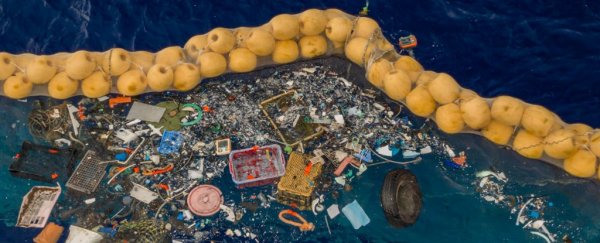It has been six years since Boyan Slat began developing a system to clean up the Great Pacific Garbage Patch, a trash-filled vortex in the Pacific Ocean that's more than twice the size of Texas.
In 2013, Slat's organisation, The Ocean Cleanup, debuted a U-shaped device that passively collects plastic in its fold like a giant arm. At first, the system hit several snags, including a flaw that caused the plastic to spill back into the ocean.
But in October, the group announced that the device was finally capturing and retaining plastic. Now, The Ocean Cleanup has brought some of that trash back to shore for the first time. Earlier this month, the group hauled 60 bags of plastic debris into the Vancouver Harbour.
"We actually have the first plastic back on land," Slat said at a press conference on Thursday. "It fills me with a lot of pride and joy."
Behind him sat heaps of plastic material covered in salt and algae.
"It's absolute garbage," Slat said. "This stuff has been in the ocean likely for decades. "
But he has a plan for all that waste: The Ocean Cleanup intends to recycle the plastic and turn it into some kind of product. What that item will be has yet to be announced, but Slat said the team hopes to start selling it by September 2020.
The Ocean Cleanup's plastic-catching device works
When The Ocean Cleanup hauled the plastic to shore, it marked the end of mission one – an attempt to prove that its plastic-catching system actually works. The organisation wants to clean up half of the garbage patch in the next five years.
"You might wonder: It's 20 years ago that this patch was discovered. Why hasn't anyone cleaned this yet? Well, it turns out that it's actually pretty difficult," Slat said.
"It's one of the roughest environments on the face of the planet."
Next, the organisation plans to launch a full-scale, fully operational system for cleaning plastic – a more advanced application of the technology it just tested. But Slat said there are still technical challenges ahead, like ensuring that the device can withstand the long-term wear and tear of the ocean.
There's also a financial hurdle.
Although The Ocean Cleanup has secured funding from major Silicon Valley donors like Peter Thiel and Marc Benioff, the organisation eventually wants its system to pay for itself. Hence the new plan to turn collected plastic into a sellable product.
'These are not going to be gimmicks'
Slat said 100 percent of the sales of whatever product The Ocean Cleanup creates will go toward financing further cleanup of the garbage patch. The group also plans to work with DNV GL, a group that develops technical standards for operations at sea, to create a public certification for products made from ocean plastic.
Right now, Slat added, companies can claim that their products are made of recycled ocean plastic even if that ocean plastic makes up just 1 percent or less of the item. The Ocean Cleanup's goal is to create a product made entirely of recycled plastic from the Great Pacific Garbage Patch.
But one of the challenges in taking on this project, Slat said, is that plastic debris is often weathered, making it harder to reuse. The Ocean Cleanup recently found that the majority of the items they retrieved from the garbage patch in 2015 were from the 2000s. Some were decades older. But Slat still thinks it's possible to repurpose the waste.
"These are not going to be gimmicks," he said. "These are going to be products that you actually want."
This article was originally published by Business Insider.
More from Business Insider:
